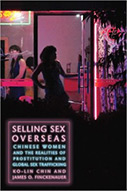Selling Sex Overseas: Chinese Women and the Realities of Prostitution and Global Sex Trafficking

Authors: Ko-Lin Chin and James Finckenauer
Publisher: New York: New York University Press, 2012. 336p.
Reviewer: Amy Farrell | November 2013
Over the past two decades the public has become increasingly concerned about the problem of human trafficking. Fueled by images of women and children forced into the global sex trade, policymakers and advocates have lobbied for laws and policies to combat the spread of sex trafficking. In Selling Sex Overseas: Chinese Women and the Realities of Prostitution and Global Sex Trafficking, Ko-Lin Chin and James Finckenauer, professors of criminal justice at Rutgers University, shed important light on the nature of transnational prostitution and the degree of human trafficking that exists in this clandestine industry.
In 2000, the United Nations adopted the Protocol to Prevent, Suppress and Punish Trafficking in Persons, Especially Women and Children. That same year the U.S. Congress passed the Victims of Human Trafficking and Violence Prevention Act (TVPA). The TVPA criminalized both sex and labor trafficking and provided significant resources for the identification and protection of victims. Similar laws have been passed in over one hundred different counties and in the U.S. all fifty states have adopted legislation criminalizing human trafficking. Despite passage of new laws and the devotion of attention and resources to combat sex trafficking, we know very little about the true nature or scope of the problem in the U.S. or worldwide. Estimates of the number sex trafficking victims vary widely and are often based on little solid data. Much of what we know about sex trafficking comes from official reports of human trafficking cases investigated by the police or stories from victims who were identified by victim service providers trained to work with human trafficking survivors. Those who seek assistance from the police or social services may be very different from those who do not. As a result, our understanding of how women and girls became involved in prostitution and the extent of exploitation involved in their experience may be biased. In the face of little empirical data about the nature, scope or magnitude of human trafficking, anti-trafficking policy has been largely guided by anecdote.
Missing from the anti-trafficking discourse is empirical data about the nature of sex trafficking. Important questions remain about the prevalence of human trafficking victims among those engaged in various commercial sex markets across different cultural contexts. Sex trafficking and prostitution are not one in the same. Under U.S. law, an adult is considered a victim of sex trafficking when they are forced, deceived or coerced into prostitution, while children induced into commercial sex are all considered to be victims. Researchers generally have not gained the type of access to commercial sex markets that is necessary to determine the frequency and characteristics of sex trafficking in commercial sex operations. Further, we lack important basic information about the organization and connection of commercial sex operations to other illicit industries such as smuggling.
Selling Sex Overseas begins to tackle these important questions. Primary among their aims is to better understand how global sex trafficking networks are organized (or not) and how prevalent sex trafficking is among a population of foreign women who are selling sex overseas. Their research is based on a unique set of ethnographic data collected in ten locations (eight in Asia and two in the U.S.) between December of 2006 and August 2008. Chin and Finckenauer conducted interviews with 149 women who were engaged in prostitution across the ten study sites. They conducted another roughly two hundred interviews with sex ring operators, government officials and non-government organization stakeholders across the ten sites to understand how women became involved in commercial sex. Additionally they conducted fieldwork visiting and observing red light districts and in some cases shadowing individuals involved in the commercial sex markets being studied.
The book chronicles the experiences of women engaged in selling sex overseas. In-depth interviews covered information from the women’s background and recruitment into commercial sex, their reasons for traveling abroad and the mechanisms of the travel, and their experiences selling sex overseas, including how their work is organized and the financial operations of the commercial sex market including their expenses and debts. Contrary to images of foreign women being forced or deceived into traveling abroad to engage in prostitution, the majority of Chinese women interviewed by Chin and Finckenauer claim they knew they would be traveling overseas to sell sex. Violence and deception were rare. Only one-third of the women they interviewed indicated any form of coercion was involved in their decision to travel overseas to sell sex or their experiences selling sex abroad. This finding stands in stark contrast to studies relying on interviews with victims identified by service providers or the police who report more abuses are more prevalent. Importantly, they found that the proportion of women who experienced violence, deception or coercion varied across study sites. For example, while a majority of the women interviewed in Indonesia experienced coercion, none of the interviewees working in the U.S. disclosed experiencing coercion. These findings suggest caution in attempting to generalize about trafficking across different regions with varied contexts that support and facilitate foreign sex work.
Chin and Finckenauer paint a complex picture of the varied roles and responsibilities faced by different actors in the transnational prostitution markets they studied. Bolstered by rich narratives from interview text and field observations, they provide readers a unique window into the lives of sex ring workers, operators and facilitators. Interviews with those responsible for organizing and managing the sale of sex suggest that women in the sites studied here face more vulnerability in some commercial sex markets due to local conditions that structure power arrangements among recruiters, facilitators and workers. And despite claims that human trafficking is a form of organized crime, those interviewed by Chin and Finckenauer argue that organized crime groups do not play an important role in the movement of Chinese women for commercial sex.
Although Selling Sex Overseas challenges popular notions about the relationship between sex trafficking and prostitution among adult foreign women, some cautions are warranted. Since sex trafficking is quite purposefully a hidden enterprise, collecting data about trafficking operations and its victims is extremely challenging. Chin and Finckenauer chose to interview women actively involved in selling sex at the time of the interview, rather than relying on information from people who had left the sex trade or escaped experiences of exploitation. They chronicle numerous methodological challenges they faced recruiting women to participate in the study. Ultimately they relied on three methods, they: 1) found women on the street who were selling sex and asked them to participate in an interview, 2) located indoor commercial sex operations and requested consent from the operator or manager to speak with the women selling sex and then asked women to consent to an interview, and 3) located women through referrals of key informants, often managers or “mommies” in brothels. As the authors note in the concluding chapter, many readers will be skeptical that the interviewees, particularly those women working under the watchful eye of sex ring managers at the time of the interview, were being truthful. While Chin and Finckenauer took a number of precautions to ensure more truthful responses including conducting face-to-face interviews in a place that was comfortable to the interview subject and ensuring anonymity to interview subjects, there are challenges inherent to interviews with sensitive subjects that may undermine the validity of the information gathered from women selling sex. Primary among them is the fact that women who were interviewed about their experiences selling sex overseas may feel compelled to deny exploitation if those doing the exploiting know she will be talking to a researcher. The women who Chin and Finckenauer located for interviews may have been recommended by key informants because they were more independent. An unknown number of women who experience more exploitation and suffer more force or coercion in the decision to sell sex overseas were not identified by the authors. Only fifteen to eighteen women were interviewed in any one study site. As a result, it is hard to generalize more broadly about the experiences of women selling sex either within or beyond the ten sites studied. These challenges are inherent in all research that seeks to collect data in natural settings.
Reading Selling Sex Overseas illuminates the complexities of transnational prostitution markets. Women have different motivations for and experiences selling sex abroad. Their experiences and their perceptions of these experiences may also change during the course of the time they sell sex, complicating the task of researchers to gauge exploitation. The women Chin and Finckenauer interviewed did not generally have the characteristics of sex trafficking victims. This finding stands in stark contrast to studies that rely on interviews with people who are working with service providers or the police who report experiencing much more exploitation and coercion. Although they leave open the possibility that women in other types of commercial sex markets may experience exploitation more in line with our understanding of sex trafficking, they conclude that anti-trafficking policy must be informed by more reliable information about the problem.
Selling Sex Overseas is an important and timely book. It should prompt scholars, policymakers and advocates to reexamine previously held assumptions about sex trafficking and prostitution. Chin and Finckenauer demonstrate that researchers can reach key actors in the sex industry and build the rapport necessary to learn about their experiences. They call on researchers to examine more deeply the market aspects and demand side of commercial sex industries in an effort to provide empirical evidence as opposed to anecdotal accounts or unsubstantiated reports upon which to develop policy. Selling Sex Overseas is an excellent read. It should provoke important conversations about both the nature of the transnational commercial sex industry and the problem of trafficking persons for sex.
Amy Farrell, Assistant Professor, School of Criminology and Criminal Justice, Northeastern University


